The 'people-to-people network' has a major impact on the spread of culture and knowledge

by
You can think of everything in the world as being connected by a “network”, and by using a system that spreads things on a network, the spread of infectious diseases and wildfires, the spread of culture and fashion, the spread of knowledge You can think about etc. Software engineer and writer Kevin Simler explains how diffusion takes place on the network using different models and discusses the impact of human-human networks on cultural trends and technological innovation.
Going Critical — Melting Asphalt
https://www.meltingasphalt.com/interactive/going-critical/
When considering a network in a simplified way, the basic point is the ' node ' on the network and the ' edge ' connecting the nodes. If you want to create a model that spreads something, label a particular node as an 'active node' and consider the situation where the active state spreads and spreads from the active node to the adjacent node.

Simler created a model in which one node is adjacent to four nodes. The model shows how things spread from the central active node to the surrounding nodes. In an actual society, since one node is a human being or the like, a model in which the number of nodes adjacent to one node is constant is not realistic, but here, one node is four for simplification. Using a model adjacent to a node.

The network can be represented by dots and lines, but even with a model using squares, the same situation can be represented without lines.

In order to better understand the spread on the network, Simler has prepared an interactive model. In this model where the blue tile in the middle represents the 'active tile' and the white tile represents the 'non-active tile', clicking on the start icon at the bottom to start the simulation ...

The middle blue tile spreads to the adjacent tiles, and the active nodes change to dark gray tiles. If things always spread to the adjacent tiles, this model is correct, but it is not the case that culture, fashion, diseases etc. actually spread around 100%.

So Simler created a model that allows you to set the 'probability of the active tile spreading things to the next tile'. When you click the icon with the default spread probability '50%' ...

You can see how the blue tiles gradually spread. In this model, once activated, tiles are inactive and removed from the model.

White tiles represent “Susceptible”, blue tiles “Infected”, gray tiles “Removed”, and this type of model is a SIR model It is called that. White tiles can be infected by blue tiles, blue tiles work on the surrounding four tiles, and tiles that have finished working become gray tiles that are virtually removed from the model.
The SIR model is useful for
If you start the simulation with SIS model with diffusion probability '35%' ...

The blue tiles spread over time and you can see that the tiles are infected extensively on the network.

In fact, in the SIS model, there are two types, the 'subcritical network' in which the expansion is eventually ended depending on the infection probability, and the 'supercritical network' in which the expansion does not stop. When simulating with a 30% probability of infection using a large model prepared by Simler ...

Gradually the infection spread and spread throughout. In the SIS model with four nodes adjacent, the 30% probability of infection is a supercritical network.

However, if you simulate with 20% infection probability ...

The infection only spreads locally and has ended eventually. An infection probability of 20% can be said to be a subcritical network.

After changing the infection probability and repeating the trial many times, it was found that the infection probability is up to about 22% for the subcritical network and 23% or more for the supercritical network. However, the probability of infection is not necessarily 23% or more, and the infection does not necessarily spread throughout the model. For example, at the very beginning of simulation, the probability determines whether one node will infect four surrounding nodes.
If the probability of infection is 50% in the SIS model, 50% trials will be repeated 5 times to decide whether to infect or not, but about 3% in calculation “possibility of not spreading infection to any node” exists To do. Although it is unlikely to simulate 3%, the infection may not spread at all. In extreme terms, even if the probability of infection is 99%, the possibility of the end of the infection is not zero. However, numerically speaking, the possibility is small, according to Simler, there is no need to consider it as deeply.
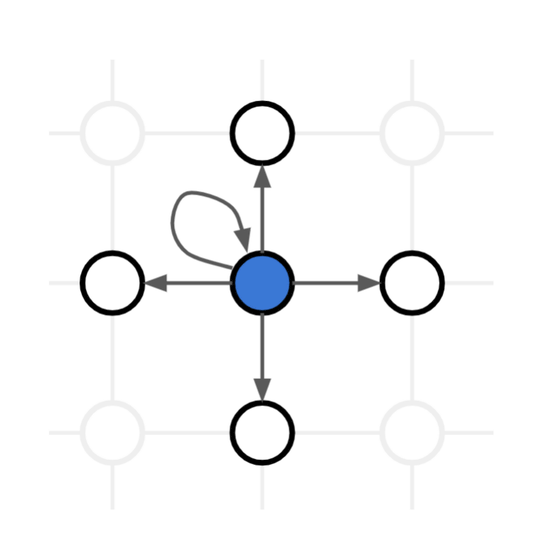
Simler has also built a SISa model in which the infection starts 'randomly and spontaneously', rather than spreading from the central node alone. The 'a' in the SISa model is 'automatic (spontaneous)', and it is possible to simulate how infection starts from multiple locations on the model by increasing the spontaneous infection probability.

However, the most interesting point in the SISa model is that the infection does not dominate the network no matter how high the probability of occurrence is. In order for the infection to spread throughout, the probability of infection must still exceed 23%, which is a supercritical network. Simler claims that this situation is similar to 'trying to fire in a damp field', and in a very high probability of infection (a dry field) the fire will spread in a single trial, but If you try to set the fire many times in the damp field, the fire will not spread after all.
Simler points out that events similar to the SISa model occur in things like ideas and inventions. Even if good ideas and inventions are made, they will not expand as a whole unless the network has a base to extend them, and will eventually disappear. The phenomenon that has been repeated historically, even if a groundbreaking invention is made is not widespread and becomes a lost technology, and the same invention is made several hundred years later, the condition of the network is the cause Simler Says.
Simler also built a model that could set up 'immunity to infection'. If you use the slider to simulate the percentage of 'immunity nodes', you can see that the probability of infection reaching the supercritical network increases as the number of immunocarriers increases. The more immune the more nodes are, the harder it is to spread the infection, which will affect the spread of the infection on the network.

Simler points out that this consideration of immunity may help to prevent the spread of wildfires. Although strict fire management can not completely prevent the occurrence of fires, it is possible to minimize expansion by making fire zones. In addition, in the case of vaccination for infectious diseases, the more people who receive vaccination, the less the spread of infectious diseases in society.

by
So far, the number of adjacent nodes has been four, but changing the number of nodes also affects the model of infection spread. If you try to increase the number of nodes that may be spread to eight, you can see that the upper limit of the subcritical network is lowered and the infection is more likely to spread.
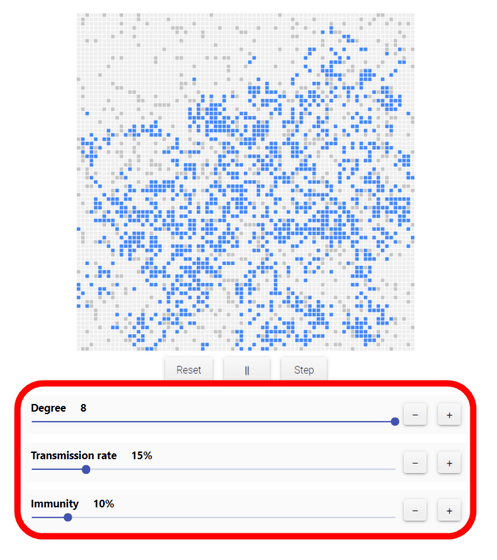
Node expansion represents an increase in network density. Simler believes that by expanding the number of adjacent nodes on the part of the network used for the model, it can simulate the spread of infection in urban areas where there is a lot of human contact, and the model is actually being created. In the model below, 'the urban area' is formed in two places, upper right and lower left, and in the urban area, the number of adjacent nodes increases to 5, 6, 7, 8 as going from the periphery to the center.
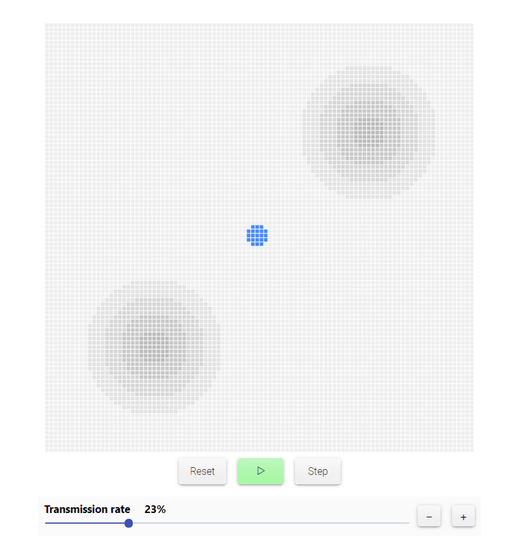
By simulating with this model, it became clear that the infection spreads rapidly in the urban area, and eventually it spreads around the urban area.
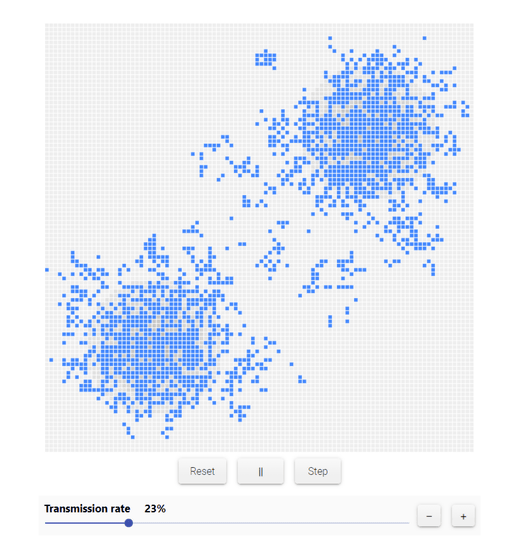
Simler says that the model 'shows that the culture transmitted from person to person is easy to spread in urban areas and hard to spread in rural areas.' Compared with urban areas where people are in contact with many people daily, the number of contacts in rural areas is less in one day, which is why fashion and culture trends are less likely to spread in rural areas. The idea is that the idea that 'invention and culture will penetrate any place' is not correct, but there is a culture that only prevails within a specific range of high network density. I have suggested.
Furthermore, there is a difference in the network density between students who interact with a large number of friends every day, even in the same urban area as in urban and rural areas, and their parents. Also, in general, the network density will be high for people located in the 'elite', so there may be a 'trend that is only flowing to the elite' that is not maintained by other networks.

In addition to culture, Simler pointed out that network density is important for expanding 'knowledge.' When someone makes a groundbreaking invention, it is necessary to incorporate new information from the outside, accumulate what is known from existing research, and then lead a good idea. In addition, inventions that disappear silently without being known to the outside have little influence on society, and a network is also necessary to spread inventions.
For the model in invention, Simler has created a simple diagram of four experts. In the figure, 'Expert 1' invents the underlying idea, and it adds new knowledge and ideas from 'Expert 2' to 'Expert 3' and spreads, and finally 'Expert 4' completes the invention It is a scheme to make it

I feel like this when I drop it into the SISa model. When you start simulation ...
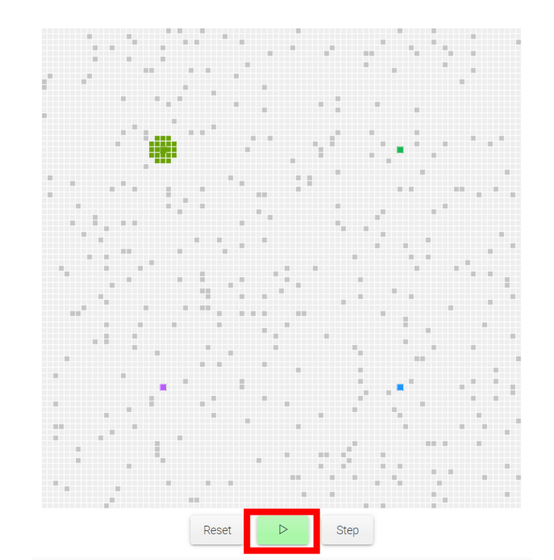
The base idea spreads out from the upper left Expert1, and the upper right Expert2 inherits it and spreads the new idea.
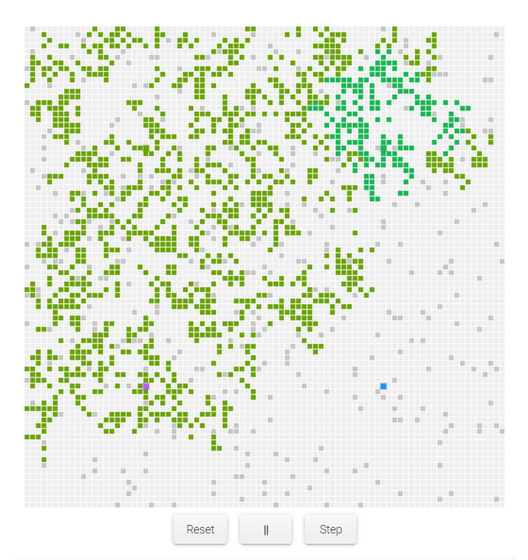
Eventually, the idea of Expert 2 is transmitted to Expert 3 at the bottom right, and further improvements are made ...
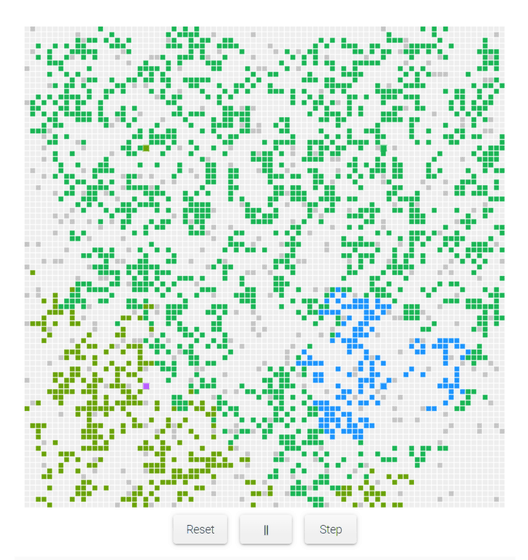
Finally, Expert 4 has created a new invention.
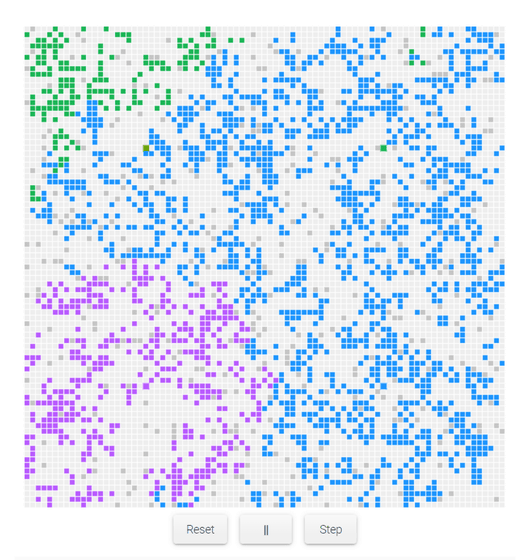
The following model is presented by Simler as 'a simpler model to speed up the invention'. There are four experts in a very close place, and in this situation we can see that the invention is created in an instant. Close to this model are existences such as 'university' and 'academy', and experts with the necessary knowledge to create inventions are located in close proximity and form a close network.
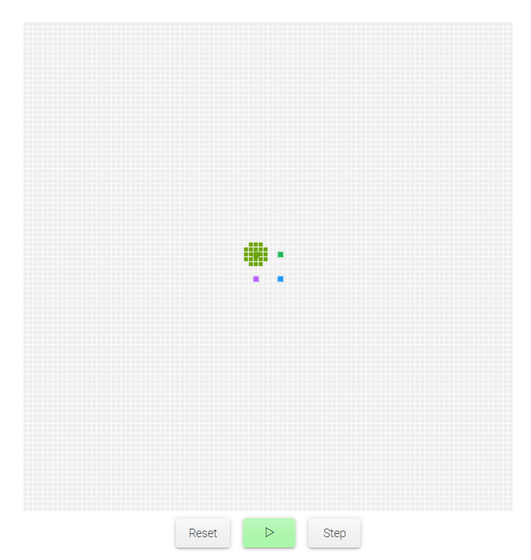
Simler also points out that the development of technology drives the growth of knowledge. In addition to the improvement of testing equipment and experimental environment by the development of technology, the innovation of communication methods and transportation means has increased the network density among specialists, creating a cycle that generates new knowledge.
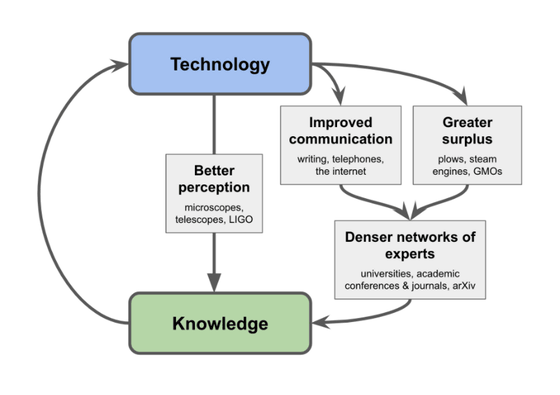
On the other hand, Simler also mentions the existence that adversely affects the network of experts. It seems to be an “ambitiously motivated expert”, and an expert who presents poorly scientifically backed research that seeks results can become a “death node” that impedes the expansion of the right knowledge. Not only that, but because they sometimes extend false knowledge, Simler said that he was a thorn in the network of experts.

Related Posts:
in Note, Posted by log1h_ik







